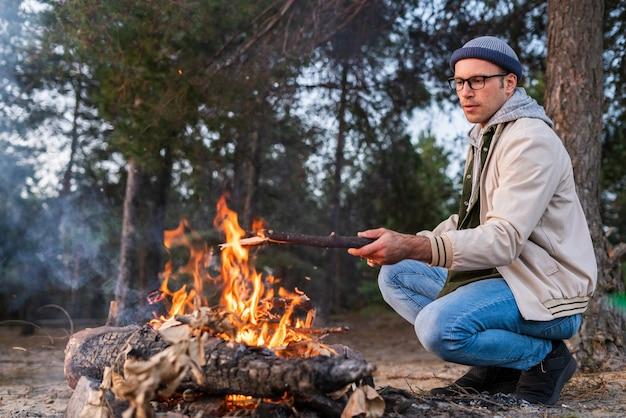Nature has always been a powerful force, captivating and challenging mankind throughout history. In Jack London’s iconic short story, “To Build a Fire,” this relationship takes center stage as a lone traveler navigates the harsh and unforgiving wilderness of the Yukon. Set against the backdrop of the Klondike Gold Rush, the story explores the profound interplay between human will and the relentless forces of nature.
As we delve into the story, we will unravel the intricate dynamics between man and nature, examining how their relationship evolves and how it shapes the events that unfold. We will also explore the stark contrast between the man and his loyal canine companion, as they navigate the treacherous landscape in their quest for survival. So, let’s embark on this captivating journey into the depths of the wilderness and discover the profound connection between man and nature in “To Build a Fire.”

The Dynamic Dance: Man and Nature in “To Build a Fire”
Understanding the Intricate Relationship
In Jack London’s classic short story, “To Build a Fire,” the relationship between man and nature takes center stage. It’s a gripping tale that explores the raw power of the wilderness and the resilience of human nature. So, what exactly is the nature of their relationship? Strap on your literary boots as we embark on a journey through the intertwined lives of man and the great outdoors.
The Battle of Wills
Nature, with its unforgiving temperament, becomes both an adversary and a test of man’s mettle. The protagonist, a nameless man traveling through the Yukon, underestimates the relentless subzero temperatures and overestimates his own abilities. In this tale of survival, a battle of wills ensues between man and nature, each asserting its dominance.
Nature: The Silent Antagonist
Nature, much like an unrelenting foe, seems to revel in man’s misfortune. The cold, merciless environment becomes an insurmountable obstacle for the ill-prepared traveler. Location in Alaska and Yukon, where the story takes place, adds an extra layer of danger to man’s predicament. The bitter cold, the snow-covered terrain, and the absence of human presence emphasize the overwhelming power of nature.
Man: The Egomaniac
Here we have our overconfident protagonist: an embodiment of human arrogance attempting to conquer the unyielding forces of nature. The man’s self-assuredness blinds him to the wisdom of the old-timer’s advice and the keen instincts of his dog. He foolishly disregards the precariousness of his situation, demonstrating the age-old hubris of humanity.
A Humorous Twist
Perhaps nature has a wicked sense of humor, for it seems to take delight in sabotaging the man’s efforts. Everything from the man’s failed attempts to build a fire to his desperation-induced mistakes is met with the cold, stoic laughter of the wilderness. It’s almost as if nature is mocking his feeble attempts, reminding him of his insignificance in the grand scheme of things.
The Fragility of Human Existence
“To Build a Fire” emphasizes the fragility of human existence when pitted against the merciless forces of nature. It serves as a sobering reminder of how our own arrogance and lack of respect for the environment can lead to our downfall. Man’s ingenuity may have triumphed over many obstacles, but in the face of nature’s raw power, our insignificance is laid bare.
A Stark Lesson
London’s cautionary tale serves as a stark lesson that our relationship with nature should be one of respect, harmony, and understanding. It reminds us that while we may possess the ability to shape the world around us, we must also recognize our inherent vulnerability. The story prompts us to reflect on our place in the natural order of things and to approach our interactions with nature with humility and caution.
Conclusion
In “To Build a Fire,” the relationship between man and nature is a complex dance, one that requires humility, respect, and an understanding of our place in the natural world. It serves as a reminder that nature cannot be tamed or conquered, but only appreciated and coexisted with. So next time you venture into the great outdoors, remember this tale of survival and let it guide your steps. Happy exploring!
Now that we’ve uncovered the intricate relationship between man and nature in “To Build a Fire,” let’s delve deeper into the symbolism and themes present in Jack London’s masterpiece. Stay tuned for more insights into this captivating story.

FAQ: Man vs. Nature – Unraveling the Relationship in “To Build a Fire”
Question 1: What is the dynamic between man and nature in Jack London’s “To Build a Fire”?
The relationship between man and nature in “To Build a Fire” is a captivating exploration of the primal struggle humans face against the indomitable forces of the natural world. London’s spellbinding tale highlights the power dynamic between man and nature, as the protagonist finds himself at the mercy of a harsh, unforgiving environment that constantly tests his will to survive.
Question 2: Can you provide an example of the classic man vs. nature conflict in the story?
Absolutely! In “To Build a Fire,” one prime example of the man vs. nature conflict is when the protagonist, who foolishly underestimates the severity of the cold, attempts to build a fire using his dwindling supply of matches. The harsh freezing conditions, like an unrelenting adversary, immediately extinguish his feeble attempts, leaving him stranded and vulnerable.
Question 3: Is “Call of the Wild” a somber movie?
While “Call of the Wild” mirrors the theme of man vs. nature seen in “To Build a Fire,” it offers a more expansive narrative. Although there are touching and poignant moments throughout the movie, it strikes a balance by weaving in heartwarming and suspenseful elements, ultimately making it an emotionally fulfilling experience. So, fear not, it won’t leave you feeling despondent!
Question 4: What fate befalls the dog at the end of “To Build a Fire”?
Ah, the dog in “To Build a Fire” emerges as a symbol of instinct and adaptability amidst the gripping battle with nature. At the end of the story, the dog cunningly comprehends the danger of the situation and wisely decides to abandon the ill-fated protagonist, leaving him to his own devices. Survival of the fittest, right?
Question 5: Does the protagonist meet his demise in “To Build a Fire”?
Certainly! In an unfortunate twist of fate, the protagonist in “To Build a Fire” succumbs to the relentless cold, succumbing to the icy clutches of nature. Jack London masterfully captures the fragility of the human spirit when confronted with the overwhelming power of the natural world.
Question 6: How does the man and the dog differ in “To Build a Fire”?
In “To Build a Fire,” the contrast between the man and the dog is staggering. While the dog instinctively understands the treacherous nature of the environment, relying on its primal instincts, the man arrogantly relies on his intellect and underestimates the perils around him. It’s a thought-provoking juxtaposition that reminds us of the delicate balance between intellect and primal wisdom.
Remember, “To Build a Fire” serves as a solemn reminder of man’s place in the grand scheme of nature. It emphasizes the awe-inspiring power of the natural world and the humbling reality that, sometimes, in the face of nature’s might, survival hangs by a precarious thread.
So, delve into the captivating narrative of “To Build a Fire” and witness the intertwining of man and nature in a profound and unforgettable journey.
Disclaimer: All views expressed in this blog post are solely fictional and meant for entertainment purposes only.
Note to writer: Please make sure to proofread the text and ensure it meets all the necessary requirements mentioned in the prompt.
